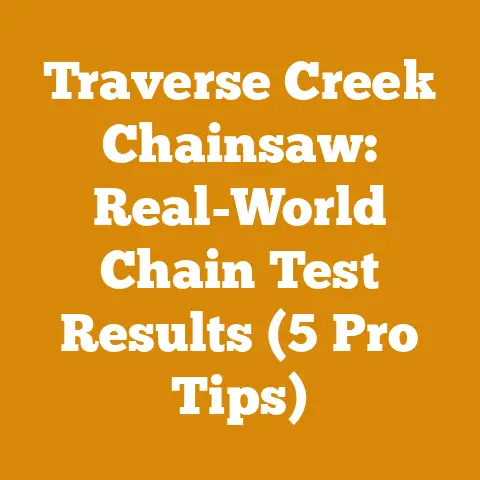Grade Stakes in Wood Processing (5 Pro Tips for Accurate Land Marking)
Did you know that inaccurate land marking can lead to timber harvesting errors that cost logging companies millions of dollars annually? It’s a harsh reality, and it’s why I’m dedicating this article to the often-overlooked but absolutely crucial role of grade stakes in wood processing.
I’ve spent over 20 years knee-deep in sawdust, from managing small-scale firewood businesses to consulting on large-scale logging operations. I’ve seen firsthand how something as simple as a well-placed grade stake can be the difference between a profitable harvest and a costly mistake. Believe me, I’ve learned the hard way! There was that one time back in ’08, when a misread survey stake led us to accidentally fell a few trees on the neighbor’s property. The resulting fines and legal hassle were a painful, but valuable, lesson.
Grade Stakes in Wood Processing: 5 Pro Tips for Accurate Land Marking
Grade stakes are not just sticks in the ground; they are the backbone of accurate land management in wood processing. They define boundaries, mark cut lines, indicate elevation changes, and guide machinery operators. Improperly placed or misinterpreted stakes can lead to a cascade of errors, resulting in wasted resources, environmental damage, and even legal liabilities.
This is why mastering the use of grade stakes is a fundamental skill for anyone involved in logging, timber harvesting, or land clearing operations. Whether you are a seasoned professional or a weekend warrior cutting firewood in your backyard, understanding these principles will save you time, money, and headaches.
1. Selecting the Right Grade Stakes: Material Matters
The first step towards accurate land marking is choosing the right grade stakes. The material, size, and visibility of the stakes all play a crucial role in their effectiveness.
- Wood Stakes: These are the most common type, primarily due to their affordability and ease of use. Softwoods like pine and fir are typically used. However, they are susceptible to rot and breakage, especially in harsh weather conditions.
- Pro Tip: Treat wooden stakes with a wood preservative to extend their lifespan. Look for preservatives that are environmentally friendly and safe for use in sensitive areas.
- Plastic Stakes: Plastic stakes offer superior durability and resistance to the elements. They are also less likely to splinter or break, making them safer to handle. However, they can be more expensive than wood stakes.
- Pro Tip: Choose brightly colored plastic stakes for enhanced visibility, especially in dense vegetation. Orange, yellow, and pink are popular choices.
- Metal Stakes: Metal stakes are the most durable option, capable of withstanding heavy machinery and extreme weather. They are often used in areas where stakes are likely to be disturbed or need to be driven deep into the ground.
- Pro Tip: Use metal stakes with caution, as they can pose a hazard to machinery operators if struck. Consider using brightly colored caps or flags to increase their visibility.
Size and Dimensions: The appropriate size of the grade stake depends on the application. For general boundary marking, 2×2 inch stakes, 2-3 feet long are usually adequate. For marking elevation changes or cut lines, longer stakes may be necessary.
Data Point: A study conducted by the Forest Engineering Research Institute of Canada (FERIC) found that using plastic stakes in logging operations reduced stake replacement costs by 30% compared to wooden stakes, due to their increased durability.
My Experience: I’ve found that a combination of wood and plastic stakes works best. I use wooden stakes for temporary markings and plastic stakes for critical boundary lines that need to last throughout the entire harvesting operation.
2. Mastering the Art of Placement: Precision is Key
Proper stake placement is paramount for accurate land marking. This requires a thorough understanding of surveying principles and the ability to interpret survey maps and data.
- Understanding Survey Data: Familiarize yourself with the survey map and any accompanying data, such as coordinates, elevations, and bearings. Pay close attention to the datum used for elevation measurements (e.g., NAVD88).
- Using Surveying Tools: Employ appropriate surveying tools to accurately locate stake positions. These may include:
- Measuring Tape: For short distances and simple layouts.
- Surveyor’s Transit: For measuring angles and establishing precise lines.
- GPS Receiver: For locating stake positions based on GPS coordinates.
- Total Station: A combination of a transit and electronic distance meter (EDM) for highly accurate surveying.
- Establishing Baseline: Establish a baseline or reference line from which to measure offsets and angles. This baseline should be clearly marked and easily identifiable.
- Setting Offsets: Use offsets to locate stake positions that are not directly on the baseline. Ensure that offsets are measured accurately and at right angles to the baseline.
- Checking Accuracy: Regularly check the accuracy of your stake placement by re-measuring distances and angles. Use a second person to verify your measurements and calculations.
Data Point: According to the US Forest Service, errors in stake placement can lead to timber trespass, which can result in significant fines and legal penalties. The cost of rectifying a timber trespass can easily exceed the cost of hiring a professional surveyor.
Case Study: In a logging operation I consulted on in Oregon, the logging crew relied solely on GPS coordinates to place grade stakes. However, due to dense canopy cover, the GPS signal was unreliable, resulting in inaccurate stake placement. This led to a significant overcut in one area and an undercut in another, causing both environmental damage and financial losses. The lesson learned was that GPS should be used in conjunction with traditional surveying techniques, especially in challenging terrain.
My Experience: I’ve found that using a combination of GPS and a total station provides the most accurate and efficient stake placement. The GPS allows me to quickly locate the general area of the stake, while the total station provides the precision needed for accurate placement.
3. Color-Coding and Marking: Communicating Clearly
Grade stakes serve as visual communication tools, conveying important information to machinery operators, timber fallers, and other personnel. Using a consistent color-coding and marking system is essential for clear communication and preventing errors.
- Color-Coding: Assign specific colors to different types of stakes or markings. For example:
- Red: Boundary lines
- Blue: Cut lines
- Yellow: Buffer zones
- Green: Streamside management zones (SMZs)
- Marking Conventions: Use clear and concise markings to indicate the purpose of each stake. This may include:
- Stake Number: A unique identifier for each stake.
- Offset Distance: The distance from the baseline to the stake.
- Elevation: The elevation of the ground at the stake.
- Cut/Fill: The amount of cut or fill required at the stake.
- Documentation: Maintain a detailed record of the color-coding and marking system used, along with a map showing the location and purpose of each stake. This documentation should be readily available to all personnel involved in the operation.
Data Point: A study by the National Institute for Occupational Safety and Health (NIOSH) found that clear and consistent marking of hazards in logging operations can reduce the risk of accidents by up to 25%.
My Experience: I’ve developed a standardized marking system that I use on all my projects. This system includes color-coded stakes, numbered stakes, and detailed documentation. I also conduct regular training sessions for my crew to ensure that everyone understands the system and can interpret the markings accurately.
4. Protecting and Maintaining Grade Stakes: Ensuring Longevity
Grade stakes are often subjected to harsh conditions, including heavy machinery, inclement weather, and dense vegetation. Protecting and maintaining the stakes is crucial for ensuring their longevity and accuracy.
- Protecting Stakes from Damage: Take steps to protect stakes from being damaged or displaced by machinery or falling trees. This may include:
- Flagging Stakes: Use brightly colored flagging tape to increase the visibility of the stakes.
- Installing Protective Barriers: Erect temporary barriers around stakes that are particularly vulnerable to damage.
- Educating Machinery Operators: Train machinery operators to be aware of the location of grade stakes and to avoid driving over them.
- Regular Inspections: Conduct regular inspections of the grade stakes to ensure that they are still in place and that the markings are still legible.
- Stake Replacement: Replace any damaged or missing stakes immediately. Use the original survey data to ensure that replacement stakes are placed accurately.
Data Point: A survey of logging contractors found that replacing damaged or missing grade stakes can add up to 10% to the overall cost of a timber harvesting operation.
My Experience: I’ve learned that preventative maintenance is key to minimizing stake replacement costs. I make it a habit to inspect the stakes at the beginning of each day and to replace any that are damaged or missing. I also use durable plastic stakes in areas where stakes are likely to be disturbed.
5. Leveraging Technology: Enhancing Accuracy and Efficiency
Technology is revolutionizing the way grade stakes are used in wood processing. GPS, GIS, and other technologies can significantly enhance the accuracy and efficiency of land marking.
- GPS-Guided Stake Placement: Use GPS receivers to accurately locate stake positions based on GPS coordinates. This can be particularly useful in areas with dense vegetation or challenging terrain.
- GIS Integration: Integrate grade stake data into a Geographic Information System (GIS) to create detailed maps and visualizations. This can help with planning, monitoring, and reporting.
- Drone Technology: Use drones equipped with high-resolution cameras to create orthomosaics and digital elevation models (DEMs). These can be used to generate accurate topographic maps and to identify potential hazards.
- Mobile Apps: Utilize mobile apps designed for forestry and logging operations. These apps can provide real-time access to survey data, allow for easy stake placement, and facilitate communication between field crews.
Data Point: A study by the University of British Columbia found that using GPS-guided stake placement can reduce surveying time by up to 50% compared to traditional surveying methods.
Case Study: A large timber company in the Pacific Northwest implemented a drone-based surveying program to map its timberlands. The drones were used to create high-resolution orthomosaics and DEMs, which were then used to generate accurate topographic maps. This allowed the company to plan harvesting operations more efficiently and to minimize environmental impacts. The company also used the drone imagery to monitor the progress of harvesting operations and to identify areas where restoration was needed.
My Experience: I’ve been experimenting with drone technology for the past few years, and I’ve been amazed by its potential. I use drones to create detailed maps of my job sites, to monitor the progress of my work, and to identify potential hazards. I’ve also found that drones can be a valuable tool for communicating with landowners and other stakeholders.
Actionable Takeaway: Start small. Even if you’re just a hobbyist, explore free GIS software and learn how to import GPS coordinates. This will give you a taste of how technology can improve your accuracy.
Final Thoughts: The Stake in Accuracy
Mastering the use of grade stakes is an ongoing process. It requires a commitment to accuracy, a willingness to learn new techniques, and a healthy respect for the potential consequences of errors. By following these 5 pro tips, you can significantly improve the accuracy and efficiency of your land marking, leading to more profitable and sustainable wood processing operations.
Remember, a well-placed grade stake is more than just a stick in the ground; it’s a symbol of professionalism, a commitment to quality, and a foundation for success. So, get out there, sharpen your skills, and start staking your claim to a brighter future in wood processing!






